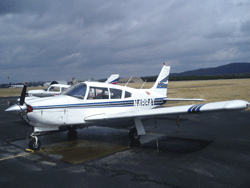At the June Safety Meeting you heard some details on uncertainty associated with the maximum range performance in the Cessna 172R and S models. Here are some additional details to refresh your knowledge of information in the AFM/POH for both the C172R and S and also the C172N.
- All models of the C172 are covered by Type Certification 3A12.
- They have the same wing, an NACA 2412.
- Dimensions in Figure 1 in both aircraft are functionally identical, i.e. wing area and span, length, height, wheel base,
- Although the R and S models have a maximum gross weight 250 lbs higher than the 1978 N model, they are certified for the same design G-loads.
- While the R and S models have 180 HP engines versus 160 for the N model, the cruise speeds are essentially equal.
- The Rate of Climb of the N model is greater than the R and S models.
- The maximum range for the N model on 50 gallons is greater than the R and S models on 53 gallons.
Essentially the design of the C 172 R and S models utilized the additional power to increase the payload, with negligible range or speed benefits. However, keep in mind that the R and S models have the benefit of dual vacuum pumps, an annunciator panel that warns of low fuel, alternator, oil pressure and vacuum pump failure, and finally fuel injection and an electric boost pump.
We should also keep in mind some important differences in how information is provided in the 1978 N model AFM/POH versus R and S models more than 25 years later! A few points are:
- The performance figures in Section 5 include the assumption that the aircraft has wheel fairings. We have removed the fairings from our aircraft to improve access for preflight inspection. Removal of the fairings results in a speed penalty of about 2 knots, with proportionate small effect on range. The 1978 N model AFM is silent on this fact but it is noted in performance specifications for the R and S models.
- To minimize the risk of fuel contamination, the R and S models have 5 sumps in each wing tank and 3 under the engine at key locations. Enjoy!
- Flaps on the R and S models the Flaps are limited to 30 degrees maximum versus 40 degrees for the model with essentially the same performance. This reduces the risk of high sink rates on short final and Loss of control (LOC) on a go-around.
- The maximum range and endurance data for the N model assumes a 45 minute fuel reserve is met by a power setting of 45 percent for all ranges. The FAA now interprets fuel reserves be based on normal cruise for the overall flight i.e. you can’t fly at 75% for 4 hours and then meet a regulatory requirement by assuming you will throttle back to 45% the last 45 minutes.
The final point about the C 172 is this accident data:
For the 12 most common General aviation aircraft, fatal accident rates by model vary from 0.56 to 2.33 per 100,000 flight hours. The safest aircraft is the C 172 at a rate of 0.56, the next safest model is the C182 at 0.76. No other model is below 1.0.








